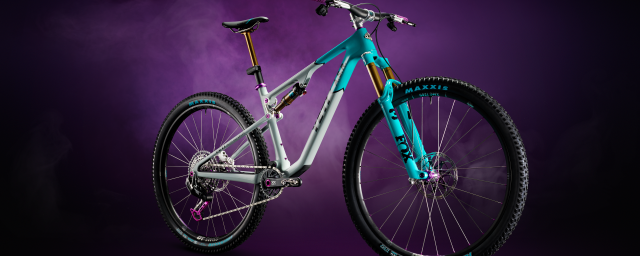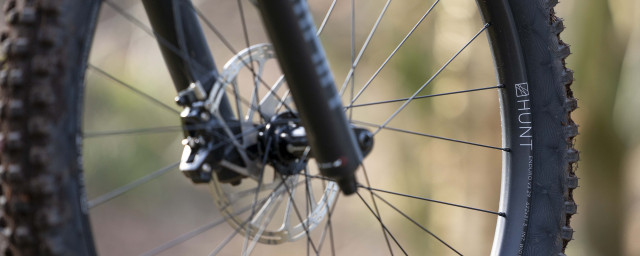Canyon Spectral:ONfly CLLCTV first ride review

With the Neuron:ONfly making its debut earlier this year, it was only a matter of time before Canyon waved its ‘Fly’ wand over the beloved Spectral. With the new Spectral:ONfly, the brand has remained faithful to the Spectral ethos having successfully relayed its excellent ride character to a lightweight TQ-equipped e-MTB platform. We’ve had the bike a couple of weeks before its launch and here’s our early verdict.
- off-road Opinion - E-bikes aren't a menace, it's all about trail etiquette
- Canyon Neuron:ON CF 8 e-MTB review
- Bike check: Sam Pilgrim's Canyon Torque:ON CF 9
Canyon Spectral:ONfly CLLCTV - Technical details
Although from the outside, it looks like the accomplished Spectral I reviewed earlier this year, and the bike uses many of the same features, this e-MTB marks a first for the Koblenz-based outfit – it’s the first e-bike in its range to be equipped with TQ’s HPR50 drive unit. Famous for its low weight, low noise and minuscule footprint, the HPR50 outputs up to 300w of power, 50Nm of torque and, combined with the 360Wh battery, promises around 1,000m of power-assisted ascent.
That 360Wh can be boosted thanks to TQ’s 160Wh range extender that fits via Fidlock’s magnetic mount. Although famed for its bottle mounts, this particular version of the Fidlock Twist Base doesn’t gel with regular Fidlock bottles, there’s just not enough clearance towards the bottom of the frame using the same mount. However, Canyon sells a compatible bottle. If you’re one for a range extender and want to save the hassle of switching bottle cages/mounts, that’ll be a great shout.
On the subject of the motor, Canyon has aimed to make the Spectral:ONfly as natural as possible, not only in the bike’s aesthetic but also in its power delivery. As such, each power mode is custom-tuned to provide more power, so it doesn’t reach its peak as abruptly as the standard settings. The lowest mode rustles up 231 watts, the mid mode goes up to 271 and high kicks out 300 watts at peak.
The Spectral:ONfly borrows most of its geometry measurements from its analogue counterpart – this includes the 64-degree head tube and 76.5-degree seat tube angle. Canyon has tweaked the bike’s measurements just to help it behave better on the climbs. As such, its chainstay has grown from 435 to 440mm and the reach has shrunk from 500mm on a large frame, down to 495mm. But to keep the cockpit feeling the same, there’s a 5mm longer stem. The e-bike’s wheelbase is also slightly longer at 1,280mm.
Another difference is the mullet bike-only build, with the brand choosing to omit the wheel size-adjusting flip-chip of the human-powered machine. But that’s a result of simple causes – there’s a wheel speed sensor to account for, after all. However, with the increased weight of any e-mountain bike, a mullet wheel setup is always appreciated in my books.
This bike takes a leaf out of the full-fat Spectral:ON’s book and dons 150mm of suspension travel at the rear wheel, and 160mm at the front.
Everything’s as expected to those acquainted with the regular Spectral, save for the understandable lack of in-frame storage. The bike gets internal cable routing, an accessory mount under the top tube, and a fat 34.9mm seat post diameter that accommodates a 200mm travel dropper on this large frame.
For a deeper look at the new Spectral:ONfly, head over to the news story.
Canyon Spectral:ONfly CLLCTV - Componentry
With this CLLCTV model, Canyon has specced it a little differently. It’s more a reflection of how Canyon’s engineers would build their bikes over at Koblenz and with that in mind, it’s graced with heavier-hitting componentry with a function-over-form angle.
Instead of the Fox 36 found on all other models is the burlier Fox 38 Performance Elite fork. That’s combined with Fox’s Float X performance shock.
Driving the bike is SRAM’s GX AXS T-Type groupset paired with a set of Code Stealth Silver brakes from the same supplier. The Spectral:ONfly CLLCTV rolls on a set of DT Swiss HX1700 LS wheels that are wrapped with a Maxxis DHR II at the rear with an EXO+ casing, and an Assegai at the front, another gravity-focussed deviation from the dual DHR II setup found elsewhere in the range.
The finishing kit is provided by Canyon’s G5 range, apart from the Fizik Terra Ridon X5 saddle. Everything here is top-notch stuff and there’s little I would change, apart from the saddle, it just doesn’t work for me.
As for pricing, this CLLCTV build will set you back a pound under £6,800. Prices then start at £5,200 and go up to £8,350. The first comparable, TQ-equipped, bike that springs to mind is the Scott Voltage eRide 910 at £6,600. As expected of a direct-to-consumer brand, Canyon has confidently trumped Scott spec-for-spec as the Voltage 910 gets lower-level suspension, drivetrain, and brake componentry.
It's a similar story for the Trek Fuel EXe 8 too, priced at £6,125 but with an alloy frame and Fox Rhythm suspension.
Canyon Spectral:ONfly CLLCTV - First impressions
The inspiration for this bike, the regular Spectral, is one that went down incredibly well in my books. It’s a cracking bit of kit for a very good price and hearing that Canyon was taking that very same formula and building it into a lightweight e-bike was not only unsurprising but also a move I was excited to sample.
And for the most part, it rides remarkably similarly to the pedal-powered bike, albeit with a few extra kilos.
When seated, the Spectral:ONfly is a pleasant place to be. Weight is very central thanks to Canyon’s attention towards the reach and chainstay measurements and because of those choices, it’s a very calm, predictable, and planted ascender. Even during more demanding sections of uphill, the bike has remained collected and controlled, despite my heart rate being anything but.
The TQ motor has a huge role to play in this respect and in leaning heavily into ‘natural’ Canyon has done a solid job of its tuning of the power modes. The motor itself hardly makes a noise. Only in the high mode does it emit a quiet whirr but how it delivers its power is smooth and almost identical to pedalling a non-assisted mountain bike. Of course, there are areas where the rear wheel can break traction as it’s overloaded with power but that’s only in areas where you might expect to spin out even a normal mountain bike.
In each of its modes, the motor tapers its output depending on the power you’re putting in, much like Shimano’s Trail mode, or Bosch’s e-MTB mode and that’s a trait I love. It promptly reacts to the power you’re putting in, or the lack thereof, and responds to suit, either allowing the rider to sit, spin, and ride the motor up a hill, or feed more power to the back wheel as the rider puts down the watts.
In this CLLCTV build, the Spectral:ONfly feels as if it’s built to chew up the descents as its long wheelbase rustles up all the stability. With that, it instils in the rider a serious level of trust in the front end, as the front wheel is fairly far out ahead of the rider so when the trail gets steep and technical, I’ve been able to let the bike do its thing and come out of sections having ridden it much faster than I perhaps would have liked, but without conceding an ounce of control.
I appreciate Canyon’s decision to pull back the reach measurement. The 495mm figure is still rather lengthy but I’ve been able to ride the front end of the bike much harder and push it more confidently in the corners. That’s all because I’ve been able to weight the front wheel more effectively, as it’s better placed under my shoulders.
Because of that wheelbase, it's a struggle to get around a corner. The longer chainstay does have its way here too but this is also where the decision to stick to a mullet wheel size pays back in dividends, clawing back vital agility points as best it can. However, with all that said, sizing down will be even more appealing on this e-MTB platform, especially to those who want all the liveliness.
Of course, this bike is still equipped with a motor and battery, which adds kilos and the weight makes itself known mostly when trying to lift the rear wheel. Elsewhere, the Spectral:ONfly does a commendable job of keeping its 20-odd kilos hidden, where there’s a feedback-rich, 'traily' vibe about the bike.
However, as I found with the Spectral CF 9, the suspension kinematic is more on the linear side of things. At the correct sag, the bike dives through its rear travel more readily, which made it feel a little soft and lacking support through heavier compressions. This will be appreciated by newer riders as the rear end is cool, calm and collected through chunk.
I added an extra 10psi to the shock which livened up the bike nicely and gave me the support that I was after but at the expense of small bump sensitivity. Adding a volume spacer to the shock will quickly solve this, and is something I intend on doing as soon as I can.
As for the distance I’ve managed to squeeze from the battery, on my biggest day so far I managed 33.74km with 877 metres of ascent over two hours and 40 minutes of constant riding time. That’s with the range extender installed and around 30 per cent power remaining.
Canyon Spectral:ONfly CLLCTV - Early verdict
So far, the Canyon Spectral:ONFly CLLCTV is proving to be an impressive addition to the lightweight e-mountain bike market. That’s all owing to its incredibly natural power delivery and wisely picked geometry in a package that you can pedal back uphill for one last bonus run. With a little bit of tweaking, namely the addition of a volume spacer in the shock, it’s poised to upset the market at this price but let’s give it a couple of months and I’ll let the full review do the talking.


















